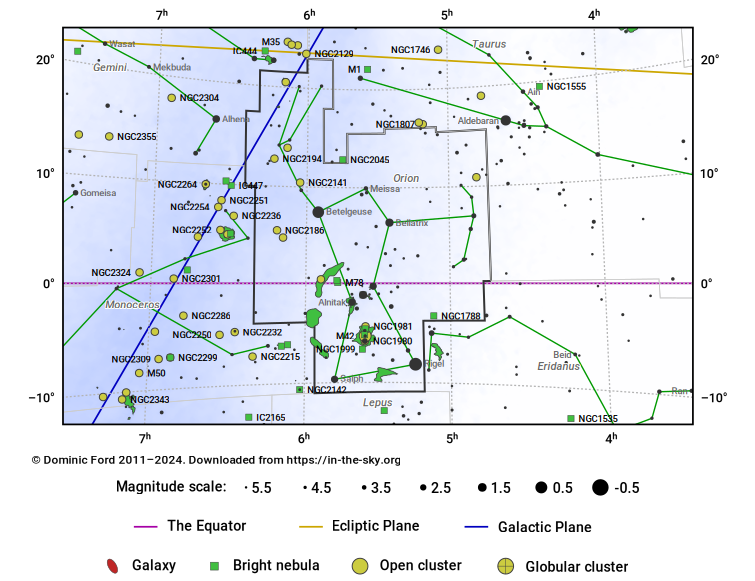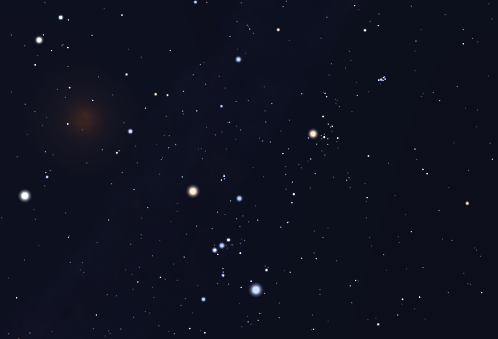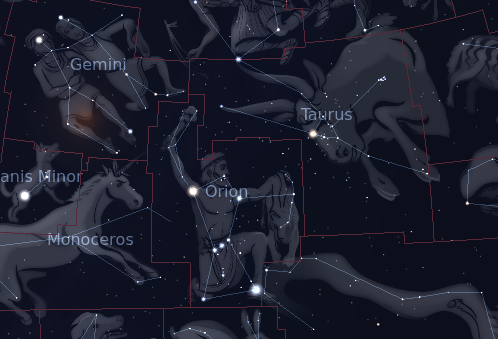The Constellation Orion
Orion is the most instantly recognisable of all constellations – the figure of a man represented by the stars Rigel and Betelgeuse, both among the top ten brightest stars in the sky.
Straddling the celestial equator, it is visible from almost anywhere on Earth, a prominent feature of the northern winter sky and of the southern summer sky.
In total, Orion is home to 10% of the seventy brightest stars, despite covering only 1.4% of the sky.
At a distance of around 250 pc (800 lightyears), these stars are not unusually close to the Earth. However, they are very large, luminous stars that shine brightly even from a long distance.
Many of these stars were born in the area around the Orion nebula (M42), the most massive star-forming region in the Sun's vicinity. M42 is one of the most brilliant of all deep sky objects, visible to the unaided eye as a smudge below Orion's belt.
In addition to the bright nebulosity of the star forming region itself, this area of the sky is also home to numerous bright open clusters.
Unsurprisingly for such a bright grouping of stars, Orion is among the most ancient constellations. The Sumerians associated it with the hero Gilgamesh, facing a charging bull represented by the neighboring constellation Taurus. Surprisingly, however, the Greeks did not associate Orion with any of their better known heros, but rather with a lesser known son of the sea god Poseidon.
Rather than associating him with Taurus, the Greeks associated him with the two hunting dogs, Canis Major and Canis Minor, said to be in pursuit of the hare Lepus at Orion's feet.
Ancient
1.4% of the sky
594.1 square degrees
Orion contains no Caldwell objects
Hover the pointer over the name of an object to highlight its position on the starchart to the right, or click to see more information.
| Stars | Open Clusters | Globular Clusters | Galaxies |
| Rigel (mag 0.3) | NGC 1980 (mag 2.5) | NGC 1924 (mag 12.5) | |
| Betelgeuse (mag 0.6) | Messier 42 (mag 4.0) | NGC 1762 (mag 12.6) | |
| Bellatrix (mag 1.7) | NGC 1981 (mag 4.2) | IC 421 (mag 12.6) | |
| Epsilon Orionis Nebula (mag 1.7) | NGC 2169 (mag 5.9) | NGC 1713 (mag 12.7) | |
| Alnilam (mag 1.7) | NGC 1662 (mag 6.4) | NGC 1671 (mag 12.9) | |
| Alnitak (mag 1.9) | NGC 2175 (mag 6.8) | NGC 1684 (mag 13.0) | |
| Saiph (mag 2.1) | NGC 2194 (mag 8.5) | NGC 1691 (mag 13.2) | |
| Mintaka (mag 2.2) | NGC 2186 (mag 8.7) | NGC 1729 (mag 13.2) | |
| TYC4766-2445-2 (mag 2.2) | NGC 2180 (mag 9.0) | NGC 1843 (mag 13.3) | |
| ι-Ori (mag 2.8) | NGC 2112 (mag 9.1) | IC 392 (mag 13.5) | |
| π³-Ori (mag 3.2) | NGC 2141 (mag 9.4) | NGC 2110 (mag 13.5) | |
| η-Ori (mag 3.4) | NGC 1663 (mag 14.5) | NGC 1875 (mag 13.6) | |
| Meissa (mag 3.5) | NGC 1977 | NGC 1819 (mag 13.7) | |
| τ-Ori (mag 3.6) | NGC 2143 | NGC 1670 (mag 13.9) | |
| π⁴-Ori (mag 3.7) | NGC 2184 | NGC 1740 (mag 14.0) | |
| π⁵-Ori (mag 3.7) | NGC 2202 | NGC 1661 (mag 14.2) | |
| TYC4771-1188-2 (mag 3.7) | NGC 1678 (mag 14.3) | ||
| σ-Ori (mag 3.8) | IC 414 (mag 14.4) | ||
| O²-Ori (mag 4.1) | NGC 1682 (mag 14.4) | ||
| φ²-Ori (mag 4.1) | NGC 1719 (mag 14.4) | ||
| μ-Ori (mag 4.1) | IC 412 (mag 14.6) | ||
| e-Ori (mag 4.1) | IC 413 (mag 14.7) | ||
| ζ-Ori (mag 4.2) | NGC 1753 (mag 14.8) | ||
| π²-Ori (mag 4.3) | NGC 1690 (mag 14.9) | ||
| φ¹-Ori (mag 4.4) | NGC 2119 (mag 15.0) | ||
| ν-Ori (mag 4.4) | NGC 1709 (mag 15.0) | ||
| χ¹-Ori (mag 4.4) | NGC 1685 (mag 15.2) | ||
| ξ-Ori (mag 4.4) | IC 2112 (mag 15.4) | ||
| A-Ori (mag 4.5) | IC 404 (mag 15.5) | ||
| π⁶-Ori (mag 4.5) | NGC 1717 (mag 15.6) |




